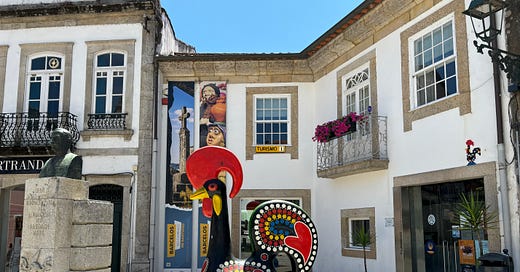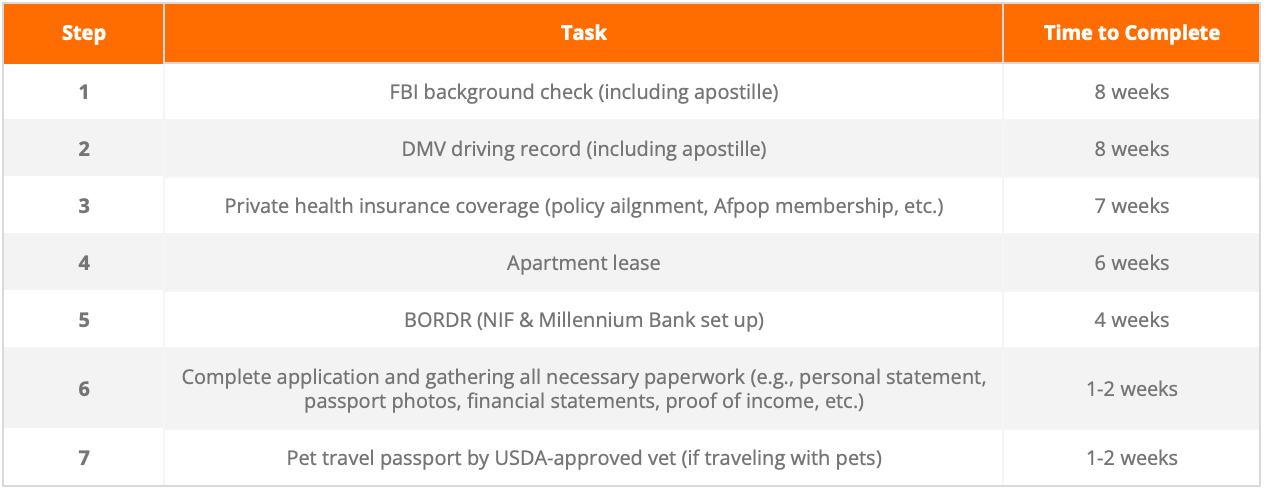About the series: Welcome to a 3-part series where I’m sharing our personal journey about moving to Portugal. Links to Part II can be found here and Part III here.
Grab your favorite beverage and get cozy, my friends.
Today, I’m kicking off the Moving to Portugal Guide by walking you through the national residency visa process.
Before diving into the nuts and bolts, let’s get a quick lay of the land first, shall we?
💡NOTEWORTHY: The information shared here — and throughout this series — is based solely on our personal experience. It’s intended as a general reference, not legal or immigration advice. This post specifically reflects US-based procedures we followed as Americans. Each country has its own visa rules and processes for Portugal, so please do your own due diligence.
Immigration Overview
Why did we need a visa?
U.S. citizens can visit Portugal visa-free for up to 90 days.
However, because we were planning to move there, we needed permission to remain for 120 days — enough time to apply for our residency permit through Portugal’s immigration office (formerly SEF but now known as AIMA — Agency for Integration, Migration and Asylum).
This initial visa granted us the extra month beyond the typical tourist stay, so we could complete the final phase of the immigration process.
So, what exactly did the Portuguese immigration process entail?
From a high-level standpoint (with more details below and in the series), we had to complete two critical steps:
Apply for a Portuguese residency visa
This required completing the appropriate visa application and gathering extensive paperwork (e.g., bank statements, private health insurance, apostilled FBI background checks, etc.).
Essentially, we assembled a comprehensive identity packet validating who we were and our financial means. This had to be submitted in person at a designated visa processing location in the US — it cannot be done from Portugal.
Apply for a Portuguese residency permit
Once we arrived in Portugal, we had 120 days to apply for our residency permit by attending an in person immigration appointment. The process was similar to our visa one but included biometric data collection — i.e., fingerprints for identify verification and security purposes. This step must be completed in Portugal.
I cover this process in Part II’s post.
Easy peasy, right?
Not quite.
Yes, the process itself was relatively straightforward but it requires meticulous planning, organization, a lot of patience and financial commitment.
My goal with this post is to share our experience and offer you a solid foundation if you decide to embark on your own relocation journey.
Here’s What We’ll Cover Today:
Residency Visa Process
Choosing the Right Visa
The first step was to identify the visa best suited for our situation.
Portugal offers several long-stay visa options, including these below:
Golden Visa: The most well-known, designed for those investing at least €500,000 in Portugal through private equity, venture capital, or urban rehabilitation programs (recently updated from real estate-only investments in 2023).
Start-Up Visa: Tailored for tech entrepreneurs aiming to launch innovative businesses in Portugal. This visa supports Portugal’s goal to become a European hub for innovation and foreign talent.
D1-D8 National Visas: A group of eight visas designed for digital nomads, retirees, entrepreneurs, and others. We applied for the D8 Digital Nomad Visa whereas others we know did the popular D7 Visa meant for retirees with passive income.
These visas permit stays up to 120 days in Portugal and allow two entries (in and out of the Schengen Zone) during that period.
What exactly is the Schengen Zone? 🧐
The Schengen Zone is comprised of 29 European countries, including Portugal, Spain, France, Germany, etc. (map here) where border controls have been lifted and you are free to travel about.
If you leave the Schengen (e.g., fly to the UK, the U.S., or Morocco), and then return, that counts as one entry. And per the visa, you’re only allowed 2 maximum entries (one of which is counted when you enter the country upon visa approval).
Visa Checklist
After selecting our visa, we followed the corresponding checklist from VFS Global —the third-party visa processing partner for Portugal.
Full disclosure: VFS Global’s website can be frustrating. Links sometimes don’t work and information can be inconsistent. For instance, the latest downloadable checklist for national visas led me in circles until I just googled it, which I found here.
💡NOTEWORTHY: Consider calling VFS with any questions you may have. Requirements can change suddenly and without notice so routinely check in with them. The checklist below reflects what was required in 2023. A downloadable version is here, with clickable links.
A few important considerations:
Securing a NIF & Portuguese Bank Account
While the VFS checklist did not explicitly require a NIF, we still needed one, along with a Portuguese bank account, to purchase private health insurance.
What is a NIF? 🧐
A NIF is your Portuguese tax identification number (i.e., Número de Identificação Fiscal). Think of it like a social security number meets expense tracker for taxes (you give it at the register whether you’re buying groceries, a TV, car, paying rent, etc.). At the end of the year, the purchases you made are offset against a portion of your taxes.
We used BORDR, a service that helped us obtain a NIF and open a bank account remotely with Millennium Bank. They handled much of the paperwork (via power of attorney), which sped up the process. There’s a discount if you buy both services at once.
How do you transfer money?
Afpop & Health Insurance
Prior to getting our health insurance, we signed up for an Afpop membership (€65/year per couple), an association for foreign residents in Portugal.
Afpop partners with MEDAL/Allianz, where we secured a premium policy including health, vision, and dental. In 2023, it cost about $1,000 per person annually. Prices doubled in 2024 but remained more affordable than U.S. alternatives.
Apostilled FBI Background Check
As noted above, you’ll need a criminal background check (FBI Rap Sheet) apostilled for use in Portugal.
What does apostilled mean? 🧐
It’s an authenticated document issued by a governmental agency in one country for international use. After fingerprinting and receiving our FBI report, we used Visa DC to get the US State Department’s apostille seal. The document had to remain unopened/untampered for our visa application.
Roundtrip Airfare
In 2023, proof of airline tickets were needed to show travel plans. We purchased refundable tickets for flexibility, as visa approvals can sometimes come after your planned travel date.
This may no longer be required but verify the latest for yourself.
Completing the Visa Application
The application, which was available on the VFS website, was pretty straight-forward.
What will take you the most time is gathering the paperwork above.
Scheduling a Visa Center Appointment
Visa appointments must be booked online well in advance—often 2 to 3 months out.
Appointments are held at VFS Global offices or Portuguese Consulates depending on your US state of residence. Since we applied from Illinois, our appointment was at VFS in Washington, D.C.
💡NOTEWORTHY: When we initially made our appointment, it was a joint one for Josh and me. Later on, we had to change it and our appointment was subsequently decoupled requiring us to schedule them months apart. I joined Josh’s appointment praying they’d see us both at the same time and, thankfully, they did!
Attending the Visa Application Appointment
The appointment itself was very simple. Once we were called, the VFS agent simply stated each document she needed from us and we handed them over — one by one.
In addition to submitting paperwork, we also had to make several payments. Below is what we paid in 2023 and I’ve also included what appears to be the new 2025 rates.
VFS service fee: $41 per person (paid by credit card | 2025 rate: $43.17)
Portuguese visa application fee: $97 per person (paid by money order to “Consulate General of Portugal” | 2025 rate: $102.24)
Prepaid FedEx envelope: $35 total for passport shipment (2025 rate unknown)
After payment, we received a visa tracking number. The entire appointment took under 30 minutes (excluding wait time).
Processing Times
We applied in late April 2023 and by late June 2023 we received approval.
Processing times vary by location:
Our DC appointment took about 2 months.
Friends who also had theirs in DC were approved in 1 month.
But friends who went to the San Francisco location waited 6 months for approval!
Keep this in mind as you try to map out moving, career transitions, and home selling/renting timelines among many other things.
Passport Collection
After receiving the green light, we sent our passports to the Portuguese Embassy (using the pre-paid FedEx envelope), where the visas were affixed.
Once returned, we were off to Portugal!
Still With Me? 👀
Remember:
There are just three more things I want to share before we wrap up:
(Yes, even more) Helpful tips and FYIs
Financial investment
Ideal timelines
Helpful Tips & FYIs
Apartment Rental 🏡
We found our apartment a few months before our visa was approved, which meant we ended up paying rent on a place we didn’t live in for about two months. Turns out, this is a pretty common experience among expats, so just a heads-up!
It also took us a solid 4–6 weeks to secure a rental. We contacted over 50 agents on Idealista, but many units were already taken or we simply never heard back. Perseverance is key!
Once we finally landed our place, we had to be prepared for a steep deposit. As foreign nationals without established local credibility, a six-month deposit was a fairly standard ask (including a pet deposit).
Traveling with Pets 🐶
Since we were traveling with our service dog, Jett, we needed to get a USDA-vet certified pet passport for her ($450).
This process took about 10 days — from the vet appointment to receiving the authorized paperwork — and it had to be valid within 10 days of our departure, so it was one of the very last steps on our checklist.
During the appointment, our vet prescribed Trazodone to help ease Jett’s travel anxiety — something you might want to ask your vet about if you’re bringing a pet along.
We found TAP Airlines had the most animal-friendly policies, making it an obvious choice. The flight attendants and airport staff at both JFK and Lisbon were incredibly helpful, often expediting us through security and immigration.
Apostilled US Driving Record 🚙
One thing we wish we’d done before moving was securing a certified and apostilled driving record (sometimes called a Driving Record Abstract) from our state DMV.
This document is necessary to exchange a US driver’s license for a Portuguese one — a requirement within 90 days of receiving your residency permit if you plan to drive legally.
Take our advice: get this done before you head to Portugal (unfortunately, neither the US Embassy nor Consulate in Portugal can do this for you). Since we don’t have a car, it hasn’t affected us, but it’s important for anyone who plans to drive.
The process usually involves two steps:
Getting the driving record from your DMV.
Sending it for apostilling at your Secretary of State.
Check your state DMV website for specifics.
Packing Lightly 🧳
Because we were uprooting our entire lives, we intentionally packed lightly.
Our apartment in Portugal was fully furnished, so we came with just four suitcases and our dog.
You can ship pallets, but be prepared for potentially long delays, as items can get held up in Portuguese customs for days, weeks, or even months!
Financial Investment
Putting it all together, here’s an honest snapshot of the actual financial investment required to make this move (based on our experience).
We believe the investment was well worth it for the quality of life we’ve been able to enjoy here. But one important consideration are taxes, which I’ll cover in Part II.
Ideal Timelines
If we could do it all again, we’d start some tasks earlier — like the FBI background check and apostille.
Here’s what we wish we knew:
And that, my friends, concludes Part I.
Phew… that was a DOOZY. 😅 I appreciate you hanging in there!
As you can tell, this process is not for the faint of heart.
But once we got through it, we realized that the juice was well worth the squeeze. 🍊
Want to learn more? Then check out Parts II here and III here!
This referral link gets you zero fees on a transfer up to $600.











